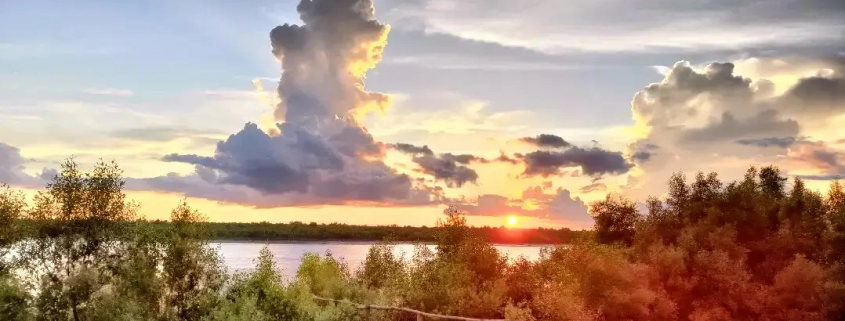Sustainable Solutions: Building a Future Where Humans and Nature Thrive in the Sundarban-Kolkata Corridor
The Sundarban-Kolkata Corridor, spanning across India and Bangladesh, is a region of immense ecological significance and unique challenges. Home to the world’s largest contiguous mangrove forest, the Sundarbans, this area is characterized by a delicate balance between human livelihoods and the natural environment.
As the effects of climate change and rising sea levels pose threats to the region, there is a growing need for sustainable solutions that can ensure the well-being of both the local communities and the diverse ecosystems. The Bangladesh-India Sundarban Kolkata tour Region Cooperation Initiative (BISRCI) exemplifies the potential for strategic cooperation and joint actions to achieve poverty reduction and sustainable ecosystem management.
Additionally, efforts in sustainable housing, community-based tourism, and integrated waterways development underscore the multifaceted approach required to build a future where humans and nature thrive in the Sundarban-Kolkata Corridor. This introductory paragraph sets the stage for exploring the various sustainable initiatives and their potential impact on the region.
5 Ways To Building a Future Where Humans and Nature Thrive in the Sundarban
The Sundarban Kolkata tour Corridor, shared by India and Bangladesh, presents a unique opportunity for sustainable development and ecosystem management. The region, home to the Sundarbans, the world’s largest contiguous mangrove forest, faces challenges such as climate change, rising sea levels, and the need for alternative livelihoods. However, there are several sustainable solutions and initiatives that can contribute to building a future where humans and nature thrive in this corridor.
Cooperative Management and Sustainable Development
The Bangladesh-India Sundarban eco tourism Region Cooperation Initiative (BISRCI) is a significant effort aimed at integrated management of the Sundarban Region, leading to economic growth through sustainable development and ecosystem management. This initiative underscores the potential for strategic cooperation and joint actions between the two countries to achieve simultaneous poverty reduction and sustainable ecosystem management.
Sustainable Housing and Local Skills
Local communities in the Sundarbans are reinventing traditional housing using sustainable self-build techniques, local materials, and circular technologies. This approach not only enhances adaptive thermal comfort and resilience to local climatic stress but also contributes to the preservation of local ecosystems and cultures.
Ecological Consciousness and Conservation
The Sundarbans is a UNESCO-listed site known for its delicate balance between land and water, nurturing diverse life forms. Efforts to raise ecological consciousness, such as Rohan Chakravarty’s ecologically conscious map of the Sundarbans, highlight the interconnectedness of the mangrove and tidal ecosystems with the local communities.
Climate Change and Infrastructure
The Sundarbans islands are facing the threat of rising seas caused by climate change, leading to the shrinking of communities. The region requires sustainable infrastructure and climate-resilient measures to address the challenges posed by environmental changes.
Inland Waterways Development
The development of inland waterways in the Sundarbans region, connecting to Kolkata, has the potential to improve the flow of goods and people, contributing to sustainable transportation and economic development.
The Sundarban-Kolkata Corridor presents a complex yet promising landscape for sustainable solutions. By focusing on cooperative management, sustainable housing, ecological consciousness, climate-resilient infrastructure, and integrated waterways development, it is possible to build a future where humans and nature thrive in this unique and ecologically significant region.
In conclusion
The Sundarban tour Corridor presents a unique opportunity for sustainable solutions that can help build a future where humans and nature thrive. By focusing on cooperative management, sustainable development, ecological consciousness, climate-resilient infrastructure, and integrated waterways development, it is possible to address the challenges posed by environmental changes and ensure the well-being of local communities.
The Sundarbans region, with its rich biodiversity and cultural heritage, can serve as a model for sustainable development in other coastal areas facing similar challenges. By working together, India and Bangladesh can create a more resilient and sustainable future for the Sundarban-Kolkata Corridor, benefiting both the environment and the people who call it home.
FAQs
How can sustainable solutions benefit the Sundarban-Kolkata Corridor?
Sustainable solutions aim to address environmental concerns, empower local communities, and promote responsible development, ensuring a harmonious coexistence between humans and nature.
What initiatives are being taken to ensure sustainability in the corridor?
Initiatives include afforestation projects, community-based conservation efforts, eco-tourism development, and awareness programs to promote responsible practices among residents and visitors.
What role does biodiversity play in the Sundarban-Kolkata Corridor?
Biodiversity is crucial for the corridor’s health, providing ecosystem services, supporting livelihoods, and contributing to the overall resilience of the region against environmental challenges.
How can individuals contribute to the sustainability of the Sundarban-Kolkata Corridor?
Individuals can contribute by adopting eco-friendly practices, supporting local sustainable initiatives, participating in conservation programs, and promoting responsible tourism.





